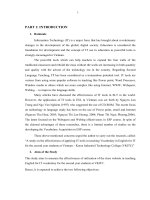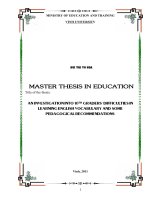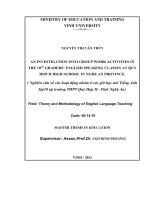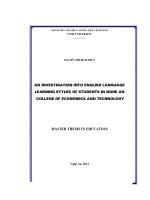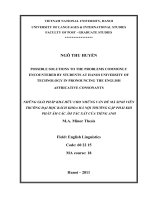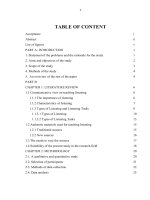Investigation into Task-based language teaching in teaching ESP to the non-English major 2nd year students at Academy of Finance
Bạn đang xem bản rút gọn của tài liệu. Xem và tải ngay bản đầy đủ của tài liệu tại đây (977.82 KB, 73 trang )
VIETNAM NATIONAL UNIVERSITY, HANOI
UNIVERSITY OF LANGUAGES AND INTERNATIONAL STUDIES
FACULTY OF POST-GRADUATE STUDIES
VŨ THỊ PHƯỢNG
INVESTIGATION INTO TASK- BASED LANGUAGE TEACHING
METHOD IN TEACHING ESP TO THE NON- ENGLISH MAJOR
SECOND YEAR STUDENTS AT ACADEMY OF FINANCE
(Tìm hiểu phương pháp dạy học thực thi nhiệm vụ trong
giảng dạy tiếng Anh chuyên ngành cho sinh viên không
chuyên năm hai ở Học viện Tài chính)
M.A. Minor Thesis Program
Field: English Language Teaching Methodology
Code: 60.14.10
HANOI- 2013
VIETNAM NATIONAL UNIVERSITY, HANOI
UNIVERSITY OF LANGUAGES AND INTERNATIONAL STUDIES
FACULTY OF POST-GRADUATE STUDIES
VŨ THỊ PHƯỢNG
INVESTIGATION INTO TASK- BASED LANGUAGE TEACHING
METHOD IN TEACHING ESP TO THE NON- ENGLISH MAJOR
SECOND YEAR STUDENTS AT ACADEMY OF FINANCE
(Tìm hiểu phương pháp dạy học thực thi nhiệm vụ trong giảng
dạy tiếng Anh chuyên ngành cho sinh viên không chuyên năm
hai ở Học viện Tài chính)
M.A. Minor Thesis Program
Field: English Language Teaching Methodology
Code: 60.14.10
Supervisor: Cao Thúy Hồng, M.A
HANOI- 2013
iv
TABLE OF CONTENT
Table of contents Page
Declaration i
Acknowledgements ii
Abstract iii
Table of content v
Lists of tables, figures and abbreviations viii
v
PART I: INTRODUCTION
I. Rationale 1
II. Aims 3
III. Scope of the study 3
IV. Overview of the study 4
PART II: DEVELOPMENT
Chapter I: THEORETICAL BACKGROUND and LITERATURE
REVIEW
I. Theoretical background
1.1. Task 5
1.1.1 Definition 5
1.1.2 Characteristics of tasks 7
1.1.3 Types of task 9
1.2. Task- based language teaching 12
1.2.1 Definition 12
1.2.2 Task- based frame work 13
1.3. English for Special Purposes (ESP) 15
1.3.1 Development of ESP 15
1.3.2 Definition 16
II. Literature Review 18
vi
Chapter II: Methodology
2.1. The context of the study 20
2.2 Research methodology 21
2.2.1 Participants 22
2.2.2. Data collection methods 22
2.2.3. Data collection procedures 25
2.2.4 Data analysis methods 27
Chapter III: Data Analysis: Results, Discussions and Recommendations
3. 1 Teachers and student’s perceptions about TBLT in ESP 28
3.1.1 Teachers and student’s perceptions about ESP 28
3. 1.2 Teachers and student’s perceptions about tasks 29
3.1.3 Teachers and student’s perceptions about features of tasks 31
3.2. Task- based language teaching realization in ESP class 32
3.2.1 Frequency of using TBLT in ESP 32
3.2.2 Task types in ESP 34
3.2.3 Task cycle in ESP 38
3.3 Problems and Suggestions 39
3.3.1 Problems in learning and teaching ESP via tasks 39
3.3.2 Suggestions 42
vii
PART III: CONCLUSION
I. Major findings of the study 44
II. Limitations of the study 44
III. Suggestions for further studies 45
REFERENCES 46
APPENDICES
viii
LISTS OF TABLES, FIGURES AND ABBREVIATIONS
List of tables:
Table 1: Teachers and Students’ opinion about ESP
Table 2: Teachers and Students’ perceptions of tasks
Table 3: Students’ perceptions of task features
Table 4: Frequency of task types used ESP class
Table 5: Problems of using tasks in ESP class
List of figures
Chart 1 (a) (b): Frequency of using TBLT in ESP teaching for the 2
nd
year
students at AOF.
Chart 2: Preferable types of tasks among students in ESP class
List of abbreviations:
AOF: Academy of Finance
ESP: English for Special Purpose
TBLT: Task- based Language Teaching
Ss: Students
1
PART I: INTRODUCTION
This initial chapter states the problem and the rationale of the study, together
with the aims, objectives and the scope of the whole paper. Above all, it is in
this chapter that the research questions are identified to work as clear
guidelines for the whole research.
I. Statement of the problem and the rationale for the study
English is being taught as a foreign language in Vietnam from
Elementary school. It is also used as a medium of instruction in secondary and
tertiary level of education. Although the students have learnt English for a
long time, they are unable to reach the expected proficiency level when they
start tertiary education. Over the years, different approaches, methods and
procedures, have been employed to help learners learn English. Some
traditional methods are GTM (Grammar Translation method), ALM (Audio
Lingual method). These methods are teacher- center, and focus on linguistic
accuracy rather than interactive or communicative competence of learners.
Learners are often passive in class and have difficulties communicating in the
real life. Since the late 20
th
century, along with globalization trends, the
demand for English as a global language in international business, travelling
and cultural exchange etc has becoming higher and higher. As a result,
nowadays, a new method of teaching and learning English to serve those
purposes has been indeed indispensable, and learner-centered approaches
have been developed. The new approaches draw knowledge from the learner,
working through their needs and interests and selecting materials, activities
and tasks accordingly. One modern method is Communicative Language
Teaching (CLT). According to Richards and Rodgers (2001), CLT is the
2
acquisition of communicative competence via student engagement in
meaningful use of language at discourse level. To achieve this, the teacher
facilitates communicative activities by managing the classroom environment,
providing resources and acting as a communicator. “Classroom activities are
often designed to focus on completing tasks that are mediated through
language or involve negotiation of information and information sharing”
(Richards and Rodgers 2001: 165). One of the most popular methods within
CLT recently is task-based language teaching (TBLT). This method promotes
communication and social interaction. In this method, learners are presented
with a task or problem to solve and do not concentrate on language features
during performance. Language analysis is incorporated after learners have
performed a task.
TBLT focuses on using the tasks which are suitable for or meet
students’ needs. The reasons are TBLT seems to bring meaningful use of
language with authentic tasks and it can promote autonomous learning. With
such advantages, it has been applied into many English courses. There is no
exception of TBLT application to English for Specific Purposes (ESP)
courses in which the requirements are the knowledge of specialization and
skills of English to achieve the goal of professional communication in
professional fields. Therefore, both ESP and task- based language teaching
method focus on learners’ needs to reach a certain goal and obviously, the
exploitation of TBLT in ESP teaching is a good choice for many ESP
teachers.
In fact, there have been some studies on application of TBLT in ESP so
far in many countries including Vietnam , yet they only focused on certain
aspects such as effectiveness, syllabus design etc. Students and teachers, the
two key factors of any teaching and learning, have not been sufficiently
3
studied. In Academy of Finance, ESP is an obligatory subject in 2 semesters
for second- year students and third- year students and ESP teachers here have
applied TBLT for their lessons. This inspired the researcher to conduct a
research on the perceptions of teachers and learners of TBLT in ESP here.
II. Aims and objectives of the study
In the first place, this study aims to identify teachers and students’
perceptions of TBLT in ESP. Specifically, the study would investigate into
how teachers and students think or feel about the task and features of TBLT in
ESP course. Secondly, a closer look is taken to find out how tasks are realized
in ESP class. In other words, the researcher tries to investigate how often
TBLT is exploited for second- year students in ESP course, which type of task
is preferred in ESP class, and how task steps are realized in class. In addition,
some pedagogical techniques to overcome the problems or disadvantages will
be provided as suggestions for TBLT application in the same context.
In brief, the researcher expects to answer three following questions:
1. What are teachers and students’ perceptions of TBLT in ESP?
2. How is TBLT realized in ESP class?
3. What are teachers and students’ suggestions for TBLT to teach ESP
course?
III. Scope of the study
First, although TBLT is generally set as the title of the whole study, it is
impossible for the researcher to cover everything related to TBLT but only
some aspects of the issue in the given context. This research only focuses on
the context of ESP course in AOF for non- major second- year students.
Secondly, the research is done to find out the perceptions of teachers and
4
students in terms of concept, features, task realization and disadvantages of
TBLT. Thirdly, it is noteworthy that the sample of the research is restricted to
60 students and 10 teachers in Faculty of Foreign languages in AOF.
IV. An overview of the rest of the paper
The rest of the paper includes 2 parts as follows:
Part B: Development
Chapter 1 – Theoretical Background and Literature review – provides the
background of the study, including definitions of key concepts, discussions of
related studies and how the present study fits into the field.
Chapter 2 – Methodology – describes the participants and instruments of the
study, as well as the procedure employed to carry out the research.
Chapter 3 – Data analysis and discussion – presents, analyzes and discusses
the findings that the researcher found out from the data collected according to
the three research questions.
Part C: Conclusion
This part summarizes the main issues discussed in the paper, the contribution
as well as the limitations of the research, suggestions for successful TBLT
application in ESP course and some suggestions for further studies. Following
this chapter are the References and Appendices.
5
PART II: DEVELOPMENT
CHAPTER 1: THEORETICAL BACKGROUND AND LITERATURE
REVIEW
This chapter sheds light on the literature of the study, specifically the
background and a number of studies related to the research topic. To begin
with, a sketchy picture of the research background will be provided with an
overview of the three key concepts, namely “task”, “task- based language
teaching” and “ESP”. Next, a brief review of the related studies will disclose
the research gap and hence, justify how the present study fits into the research
area.
I. Theoretical background
1.1. Task
1.1.1 Definition of task
In any class, activities are given to achieve certain goals of the lesson.
In other words, teachers try to design various activities for getting learners’
involvement to reach purposeful objectives. So are activities tasks or tasks
simply the same as the popular term, so- called exercises?
Nunan (2004) said: “the concept of “task” is a very important element
in every syllabus design, classroom teaching and learner assessment” (p.6).
This big role of task leads to a variety of its definition.
Prabhu (1987) suggested that a task is an activity in which learners are
required to reach an outcome from given information and during this process
the duties of teachers are to control and regulate.
6
Willis (1996:26) also defined a task as an activity in which the learners
use the target language “for a communicative purpose” to “achieve an
outcome’.
Two definitions above reach an agreement that a task is a purposeful
activity and used in teaching and learning the target language with
communicativeness. The ultimate goal of each task is to reach certain
objectives of the lesson through a process of the students’ involvement.
Teachers, of course, are not centered in carrying out a task, the centeredness
or the focus of each task is students. With task implementation, the role of
teachers and students in class has changed in comparison with old methods;
the teachers are just facilitators. Teachers just guide, control and support
students’ working in a task.
Here is another definition of tasks:
“an activity or an action which is carried out as the result of processing or
understanding a language. For example, drawing a map while listening to a tape,
listening to an instruction and perform a command may be referred to as tasks.
Tasks may or may not involve the production of the language […] A task usually
requires teachers to specify what will be regarded as the successful completion of
the task. […] The use of different kinds of tasks in language teaching is said to
make language teaching more communicative …since it provides a purpose for a
classroom activity…”
(Richards, et al (1986: 289)
The definition above seemed to agree on the point that task is as a
work-plan in classroom. It tells readers what students do in a task and
emphasize the purposeful characteristic of a task. Various types of activities
can be exploited in a task to reach a given goal of the lesson specified by the
teacher. A task serves the need of teaching and learning a language in a
communicative way.
7
There have been various definitions of tasks so far. However, in this
study, the researcher suggested the Nunan’s definition that tasks are “a piece
of classroom work which involve learners in comprehending, manipulating,
producing or interacting in the target language while their attention is focused
on mobilizing the grammatical knowledge in order to express meaning and in
which the intention is to convey meaning rather than to manipulate form”.
(2004: 9)
Nunan’s definition expresses a matter in employing tasks in teaching a
language, that is form and meaning- focus. A task should have meaning as
“primary focus”; however, this does not mean that form or grammar is not
important. Obviously, Nunan’s definition highlights the interrelation of form
and meaning. Therefore, implementing a task requires the focus both on form
and meaning to achieve a task completion.
1.1.2 Characteristics of task
Different scholars can characterize tasks in different ways because of
their different approaches.
According to Littlewood (1993), tasks have some basic features:
Tasks are activities in which students work purposefully towards an
objective.
The objective may be one that they have set for themselves or one which
has been set by the teacher.
Tasks may be carried out individually or (more often) in groups.
Tasks may be carried out in competition with others or (more often) in
collaboration.
8
The outcome may be something concrete (e.g. a report or presentation) or
something intangible (e.g. agreement or the solution to a problem).
He also distinguished tasks and exercises. Learning activities in which
students “focus upon and practise specific elements of knowledge, skills
and strategies needed for the task” without a communicative purpose are
called “exercises.” (CDC, 1999a, p. 44) The difference of exercise and
task and combination of exercise and task is highlighted in the table
below:
Exercises
Exercise-Tasks
Tasks
Low degree of
communicative purpose
and contextualisation
Contextualised practice
of discrete items
High degree of
communicative
purpose and
contextualisation
Focus on discrete items
and/or skills
Purposefulness
and
contextualisation
(Littlewood, 1993)
It can be seen that an exercise is exploited to support the task. Teachers
tend to combine these two kinds of activities for knowledge enhancement and
skills practice.
Skehan (1998) put forward five key characteristics of a task in terms of
task- focus, task types, task priority and task assessment as follow:
Meaning is primary
9
Learners are not given other
people’s meaning to regurgitate
There is some sort of relationship to
comparable real- world activities
Task completion has some priority
The assessment of the task is in
terms of outcome
To conclude, main features of tasks are goal- directed, priority for outcome,
meaning focus rather than form focus, variety in activities and work forms
from individual to group work.
1.1.3 Types of task
1.1.3.1 General types of task
Typology for TBL task design lists six task types and their
corresponding outcomes (Willis, 1996:149):
Task Types
Tasks’ Outcomes
Listing
completed list or draft mind map
Ordering & sorting information
sorted according to specific criteria
Comparing
identification of similarities &
differences
Problem solving
finding solutions to problems
Sharing experience
exchanging opinions & attitudes
Creative tasks end product
be appreciated by audience.
10
Pica, Kanagy and Falodun (1993) (in Richards and Rodgers (2001:
234), put tasks into five categories according to the type of interaction that
occurs in task accomplishment:
Types of tasks
Features
Jigsaw tasks
learners combining different pieces of
information to form a whole
Information-gap tasks
One student or group of students has
one set of information and another
student or group has a complementary
set of information. They must
negotiate and find out what the other
party's information is in order to
complete an activity.
Problem-solving tasks
students are given a problem and a set
of information. They must arrive at a
solution to the problem. There is
generally a single resolution of the
outcome.
Decision-making tasks
students are given a problem for
which there are a number of possible
outcomes and they must choose
through negotiation and discussion
Opinion exchange tasks
These tasks engage learners in
discussion and exchange of ideas.
They do not need to reach agreement.
Despite different approaches to tasks and task types, there still exists
some overlapping between Willis’s classification (1996) and that of Pica, et.
11
al (2001). For instance, creative end product task can include decision-
making tasks etc. Therefore, teachers should combine these types suitably to
get the most effectiveness.
1.1.3.2 Real- world and pedagogical tasks
This is a broad classification by Nunan (1989). He divided tasks into
real-world and pedagogic one. Richards and Rodgers (2001: 231) shared the
same opinion as Nunan and they divided types of tasks as follows:
Because the authenticity in task- based teaching is very important to get
the goal, teachers can make use of real- world task as a source or model for
pedagogical actions. However, it is necessary that teachers be careful when
they turn a real- world task into a pedagogical task. Otherwise, the task will
not work effectively. For example, with a real- world task such as “drawing a
person doing something”, we can apply to a pedagogical task when teaching
Present continuous through an activity “One student draws a person doing
something and others guess the activity using present continuous structure.” If
we use this real- world task to teach Pronouns (he/ she etc.), the activity is
Types of tasks
Features
Real-world tasks
Designed to practice or rehearse those
tasks that are found to be important in
a needs analysis and turn out to be
important and useful in the real world.
Pedagogic tasks
Have a psycholinguistic basis in SLA
(second language acquisition) theory
and research but do not necessarily
reflect real-world tasks
12
less interesting. Therefore, teachers can follow students’ needs to outline the
goal of each lesson and choose a better type of task and adapt tasks suitably.
1.1.3.3 Focused tasks and unfocused tasks
The term “focused” and “unfocused” tasks were proposed by Ellis
(2003). In unfocused task, “no effort is made in the design or the execution of
a task to give the prominence to any particular linguistic features” (p.204).
However, focused tasks do “result in some linguistic feature being made
prominent” (p.204). As a result, focused task has two main aims: the first one,
like unfocused task, is to “stimulate communicative language use” and the
second is to “target the use of particular and predetermined linguistic features
in meaning- centered communication”
Willis’s and Pica, et. al’s classification seem easier for students to
recognize than others’ in comparison with the classification of Nunan or Ellis.
The classification of Nunan or Ellis is often taken notice of by teachers rather
than students when teachers design tasks with objectives of the lessons.
Besides, as said above, some types of tasks of Pica, et. al and Willis are
overlapped; as a result, it does not make so much differences to choose
Willis’s types or Pica’s ones and the researcher would focus on Willis’s to
refer to in this study.
1.2 Task- based language teaching
1.2.1. Definition of task- based language teaching
Task- based language teaching has been one commonly used method
recently in relation with CLT approach. This term was firstly introduced by
Prabhu in his secondary classes in Bangalore, India in Communicational
Teaching project in early 1979. Since then, it has spread throughout the
world.
13
Richards and Rodgers (2001: 223) said: “task-based language teaching
refers to an approach based on the use of tasks as the core unit of planning
and instruction in language teaching". Thus, the authors stress the importance
of tasks in TBLT method to arrive at the objective of language teaching. They
also believe that TBLT draws on functional, interactional and, in some cases,
structural models of language.
Many scholars agree that TBLT is “based on theory of language
learning rather than theory of language structure” (Edwards and Willis, 2005:
13)
To develop this idea in detail, Ellis (2003:65) claimed that “TBLT is
mostly about the social interaction established between learners as a source of
input and means of acquisition, and involves the negotiation of meaning,
communicative strategies, and communicative effectiveness”. This means that
TBLT focuses on meaning and interactive communication, it does not focus
much on form.
1.2.2. Task- based frame work
The application of task- based admits variety. Lots of procedures and stages,
therefore, have been devised so far.
According to Willis (1996), there are four stages in TBLT as the
following structure:
Pre- task Task Preparation Task realization Post task
In the Pre- task stage, the teacher (facilitator) ‘explores the topic with
the group and highlights useful words and phrases’. Some activities can be
applied in this stage such as material exploitation: using a picture/text etc. to
14
lead into the topic, brainstorming: making a list; comparing ideas; sharing
experiences, activating language: eliciting and providing vocabulary.
In the second stage, the learners are expected to raise up. This phase
focuses on the importance of preparing learners thoroughly, where necessary
rehearsing the task in order to recycle the language and familiarize learners
with the context as much as possible. This stage could involve learners in a
discussion of their attitudes to it, and preparing their arguments for a debate,
or their ideas for a leaflet to draw peoples’ attention to the issue. Learners
prepare own input for tasks such as planning a report, practicing role-play,
writing a questionnaire to be administered, thinking of issues in a debate,
brainstorming necessary language, activating language: eliciting and
providing the necessary language.
In the next stage, this part of the task cycle will mirror as closely as
possible an authentic undertaking. Learners produce/perform/present their
tasks e.g : Producing a poster, Performing a role-play, Having a debate,
Producing a leaflet, Giving a presentation
In the last stage of Post-Task, there are some options such as Language
focus, Feedback and evaluation, Reflection upon task realization, Language
reflection.
There is another way to divide the stages in TBLT by Long and
Crookes (1992). Task has 3 phases: Pre- task, task cycle and language focus.
In the pre-task stage, the topic is defined and essential vocabulary is
highlighted by the teacher. In the task cycle, learners perform the task in pairs
or small groups; rehearse their reports before presenting findings in front of
the audience. The final stage is the language focus, during which specific
language features that learners encountered in the task are examined and
15
analyzed. Some practice of language features and feedback on students’
performance are appropriate at this stage.
Skehan (1996b: 24) also suggested stages of task- based
implementation with clear purposes of each stage.
Stages
Purposes of stages
Pre- task
Cognitive: ease subsequent processing load
Linguistic: introduce new forms into attention
During- task
Manipulate pressure: influence processing balance
Calibrate: influence processing balance
Post- task
Retrospect: remind learners of importance of form
Ellis (2003) believes that they all have in common three principal
phases: pre-task, during task, and post-task. In pre-task phase the overall
purpose of this phase is to prepare the learners for the next phase, that is,
students should get prepared for completing the task. In fact, the pre-task
phase has two basic functions: 1) to introduce and create interest in doing a
task on the chosen topic, and 2) to activate topic-related words, phrases and
target sentences that will be useful in carrying out the task and in the real
world communication. In the "during task" phase students work in pairs or
groups although this is dependent on the type of activity, and they use
whatever linguistic resources they possess to achieve the goals of the task.
The post-task phase in the framework, the language focus, provides an
opportunity for form-focused work.
It is clear that there are phases in task- based cycle. Each stage has its
specific purposes to achieve. It is crucial that teachers realize these purposes
to facilitate students’ learning.
16
1. 3. English for Special Purposes (ESP)
1.3.1 Development of ESP
Since the early 1960’s, ESP has become one of the most prominent
issues in EFL teaching. Its growth is reflected in increasing number of
universities offering ESP course, even MA in ESP such as University of
Birmingham (England). This is because ESP derives from the needs to use
language as a tool in professional life, not as a hobby or so-called
communication.
Gatehouse (2001) pointed out 3 main factors which led to the rapid
development of ESP. They are: the demand of Brave New World, the
revolution of linguistics, and focus on the learner. The Brave New World,
which was concerned with 2 major events (the end of the World War II and
the Oil crisis), led to the exchange in science, technology and economy. At
that time, English became the language of these changes. Therefore, English
for science, economy etc. was paid much more attention to. The second reason
is the changes in language teaching and learning. It means that languages
should be learnt for many purposes. Some scholars claimed that language
should vary in different situations; therefore, it is necessary to adjust language
to meet learners’ needs in specific contexts. Finally, ESP was stimulated when
learners became the center of language teaching. Language was designed to
satisfy learners’ needs and interests.
1.3.2 Definition of ESP
ESP has gained ascendency in different fields (Johns & Dudley-Evans,
1998). They suggested that ESP has been defined by needs of a specific
group of learners". (p. )
17
Strevans (1988; cited in Dudly-Evans and St John, 1998, p. 4) defines
ESP in terms of four absolute characteristics and two variable characteristics.
The absolute characteristics are that ESP consists of English Language
Teaching which is:
- designed to meet the specified needs of the learner;
- related in content (that is in its themes and topics) to particular disciplines,
occupations and activities;
- centered on language appropriate to those activities in syntax, lexis,
discourse, semantic and so on, and analysis of the discourse;
- in contrast with 'general English'.
The variable characteristics are that ESP may be restricted as to the
learning skills to be learned (for example reading only); may not be taught
according to any pre-ordained methodology.
Robinson (1991) believes that ESP is a major activity around the world
today. It has 2 criteria and 2 characteristics. The two criteria are the
following: ESP is normally goal- directed; needs analysis contributes to the
development of the courses and should specify what student will use English
for. The two characteristics involve limited period of time in which the
objectives are achieved and homogenous classes of adults in terms of the
work or specialist studies the students are involved.
Hutchinson and Waters (1993) emphasized that: ESP is not a matter of
teaching specialized varieties of English, nor is just matter of science words
and grammar for scientists. It is also not different in kind from any other form
of language teaching as far as principles of effective and efficient learning are
concerned.
In short, ESP is in contrast with “general English”. Besides, it meets
specified needs of learners because its content is in a close relation with
18
learners’ occupations or professional activities. The language in ESP is also
appropriate to these activities. Moreover, it may be limited to skills to be
learnt.
II. Literature review
Using TBLT in ESP course is not a new idea and it has got a lot of
researchers’ attention.
Kavaliauskienė, (2005), studied the relationship between TBL and
students’ outcomes in ESP lessons. This article addresses research into
learners’ attitudes to Task-Based Learning, and the investigation of TBL
influence on learning outcomes in the English for Specific Purposes (ESP)
classroom. The research reveals that teaching through tasks creates favorable
learning conditions for students who study English for Specific Purposes
(ESP) at tertiary level. Specifically, TBLT helped them with build-up of
professional vocabulary, development of speaking skills, and refinement of
listening skills. Concerning participants’ favorite task types, sharing personal
experience and problem- solving are two most favorable types ones (83%).
There is also a relating research by Patricia (2009). It investigated into
the application of task- based instruction in an ESP course in the computer
centre at the University of Costa Rica. The study stressed the benefits of
TBLT in ESP course. TBLT is more motivating, more challenging, more
innovative, more appealing and more meaningful to students than other
traditional grammar-based approaches. Moreover, the study listed some
considerations ESP teachers should take into when employing TBLT in ESP
such as the integration of different language skills within the TBL framework,
the use authentic materials (oral or written) to design the lesson, the role of
comprehensible and meaningful input etc.
